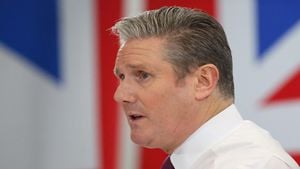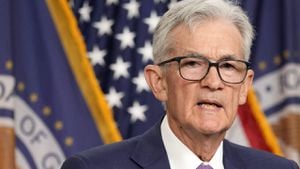Central banks around the globe are treading cautiously as they navigate uncertain economic waters, and the Bank of England (BoE) is no exception. On Thursday, the BoE announced it will maintain its key interest rate at 5 percent, marking its decision against the backdrop of varying fiscal policies from other major financial institutions. The decision follows a prior cut from 5.25 percent made just last month, which was the BoE's first rate reduction since 2020, aimed at alleviating the financial strain felt by many homeowners dealing with soaring mortgage rates.
This recent move is particularly significant considering the prevailing climate of global economic instability. Despite previous optimism, inflation refuses to ease, with the Consumer Price Index (CPI) persistently hovering at 2.2 percent—well above the BoE's target of 2 percent. This persistent inflation has placed the central bank between a rock and a hard place, torn between fostering economic growth and controlling the inflationary tide.
Rob Morgan, Chief Investment Analyst at Charles Stanley, emphasized the precarious balancing act the BoE must undertake. He stated the operational realities require the BoE to adopt a cautious stance, and the decision to hold rates today reflects this prudence. Sanjay Raja, Deutsche Bank's Chief UK Economist, mirrored these sentiments, highlighting the unlikelihood of future rate cuts due to inflation pressures.
Meanwhile, across the Atlantic, the Federal Reserve opted for change. Just the day before, Fed Chair Jerome Powell announced the first interest rate cut since 2020, easing rates by 50 basis points to 4.9 percent. This shift signifies the Fed's proactive approach to invigorate its economy amid signs of slowing growth and inflation. Powell noted increased confidence in managing inflation alongside promoting job stability.
Following the Fed's lead, the Hong Kong Monetary Authority also made headlines by reducing its base rate by 50 basis points to 5.25 percent. The authority's decision was driven by its currency peg with the US dollar, emphasizing the need to temper borrowing costs to bolster the economy. Nevertheless, HKMA Acting Chief Executive Howard Lee warned of prolonged high-interest rates as the city balances financial stability against economic support.
Canada finds itself on another narrow path, with speculation about a potential rate cut looming as inflation remains stable at the Bank of Canada's target of 2 percent. Yet, signs of economic slowing also loom, prompting hawkish analysts to advocate for monetary easing. Recent data indicates only modest increases to the CPI, glinting hope for the central bank to stimulate growth.
Over on the continent, the European Central Bank (ECB) embraced cautious optimism as it cut its interest rate to 3.75 percent for the first time nearly five years. ECB President Christine Lagarde hinted this could signal the dawn of new, more accommodating monetary policy, contingent on thorough evaluations of forthcoming economic indicators.
Even India isn’t immune to this swirling vortex of economic dynamics. The Reserve Bank of India is expected to maintain its interest rates during its upcoming meetings, as domestic inflation drove slight upticks and global trends toward rate cuts factor heavily. The RBI faces considerable pressure to manage inflation and stabilize economic growth amid fluctuative international conditions.
Many advocates for reduced interest rates champion the notion of economic stimulation, promoting borrowing and resulting investments to invigorate economic activity. They argue lower rates can facilitate growth and reduce unemployment by encouraging business expansion and hiring. Under stable inflation conditions, reductions could prolong the economic bull run without influxing excess inflation.
Conversely, critics caution against the risks entwined with lowering interest rates, especially with inflation remaining stubbornly high. Persistent inflation could be exacerbated by cheaper borrowing costs, leading to declining purchasing power. A cautious approach by central banks can provide necessary stability and avert overheating during turbulent economic climates.
Globally, the diverse monetary strategies illuminate the stark contrasts between central banks responding to their unique set of economic conditions and challenges. While the BoE remains on the sideline for now, other major banks are decidedly pivoting toward easing policies. Going forward, this juxtaposition will play out against the backdrop of financial stability and economic revitalization efforts directly influencing future policy decisions.




